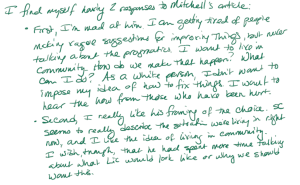Responding to What You Are Reading
Reading may seem like a solo activity, but in fact, when you work with a text, even if you are the only one reading it, you enter into a conversation with it, responding with your thoughts, ideas, and feelings. As you read, your annotations can and should include these responses, particularly the ones that are significant to you. Those responses can help you learn the material because we remember better the things that we care about. They can also help you process the ideas in the text, which can help you develop your own. Working through your response can also help you prepare for class discussions.
The way each of us responds to any text has a lot to do with who we are: our age, gender, education, cultural background, religion, ethnicity, and so on. Those responses are also grounded in our experiences: what we have done and seen, where we have lived, who we have known. Our identities and experiences form a context for engaging with a text.These responses can help us both process a text and use it. Our responses can help us identify questions, concerns, and issues involved in the text, which can become elements in our learning.
While it is possible to misunderstand a text, there is no such thing as a “wrong” reaction. You feel what you feel, and your experiences with the text are your own. But when working with a text, you want to do more than let those feelings and experiences float by on the surface. Instead, try to think them through a bit.
Here are some guiding questions to help you:
- Do you find yourself responding with a strong emotion? If so, why do you think that may be happening?
- Are there ideas that challenge ones you have held in the past?
- Can you identify with the text’s central idea or the information it’s sharing?
- Have you had any experiences like those being described?
- Are you finding the ideas or even the language of the text uncomfortable or even disturbing?
- What questions do you have about the ideas and the text itself?
- Are there areas in the text where you want more information or additional examples from the author?
- Are there circumstances or perspectives that the author didn’t consider?
- Are there questions you would want to ask the author?
- Are you reading easily and fluidly, or are you finding it difficult to navigate the text? Why do you believe this is so?
- Does the organization of the text make sense to you?
- Are you seeing connections among ideas easily or are those connections difficult for you to make?
- Does the language use (e.g., punctuation, dialect or jargon, complex sentence structure) affect your ability to work through the text?

I wrote my responses (in the image to the right) on the last page of the PDF file of Mitchell’s article.
This has the advantage of being right where I need them when I’m thinking about the text.
Also, writing a response doesn’t have to take a lot of time; I wrote mine in about ten minutes.
I didn’t realize that I was mad about Mitchell’s lack of specificity until I wrote about it. This kind of thing happens frequently to me. I don’t necessarily think about my responses until I write about them. In writing down our ideas, we figure out what we mean, what we care about, and what we think.
You may hear this called “writing to learn.” Instructors sometimes assign short, low-stakes writing assignments (like free writes or journals) to get students thinking about their ideas in a space that doesn’t have a big impact on your grade. But even if an instructor doesn’t require this kind of writing, you can use it for yourself.
Take a few minutes and write out your responses to the article you have selected. These can be in the form of a paragraph like I did, but they could also be in notes or drawings or even part of your annotations. You will use your Reading Log for this activity (included in your study guide).
Once you have written your response, take a moment to think about what you have learned or otherwise gained specifically through that response. Do you better understand something about the article? Do you have an idea for a paper topic? Do you see a connection that you didn’t before? Something else?
Key Points: Responding to What You Are Reading
- Your responses to texts can be very helpful as you try to use them.
- Include your responses in your notes and annotations.
Text Attribution
This chapter contains material taken from the chapter “Explore the Ways the Text Affects You” from The Word on College Reading and Writing by Carol Burnell, Jaime Wood, Monique Babin, Susan Pesznecker, and Nicole Rosevear and is used under a CC BY-NC 4.0 license.
